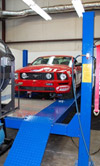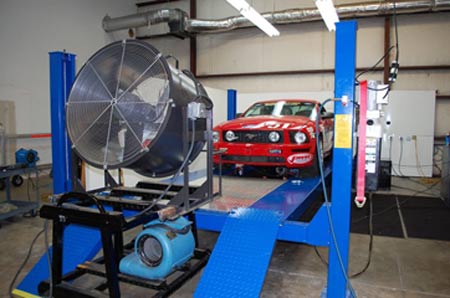The chassis dyno
 Chassis dynamometers are one of the most common methods for assessing the power output of race engines, thanks to the ease with which testing can be conducted. However, because the entire vehicle package is under test there are a large number of factors that can affect the accuracy and repeatability of the testing process.
Chassis dynamometers are one of the most common methods for assessing the power output of race engines, thanks to the ease with which testing can be conducted. However, because the entire vehicle package is under test there are a large number of factors that can affect the accuracy and repeatability of the testing process.
To recap, there are two main types of chassis dynamometers (dynos) in widespread use these days - inertia and eddy current.
Previous issues of RET-Monitor have covered the operation of both types of dyno; the important factor here is that even if all other conditions are equal, the power numbers produced by one over the other will invariably differ. This is very important to consider, especially if circumstances dictate that a test programme takes place in multiple locations, on different dynamometers. Engineers have long recognised these discrepancies and thus 'correction factors' are applied to raw dyno data, the most common being SAE J1349 and SAE J607, which take into account factors such as humidity, barometric pressure and air temperature.
When comparing dyno results, always ensure that the numbers are corrected to the same standard. However, even with proper application of these correction factors, atmospheric conditions can play an additional role, having an effect on ignition timing in modern ECU-controlled engines.

The SAE correction factors account only for the change in the density of the air due to atmospheric conditions, and cannot account for things like engine borderline spark sensitivity. As inlet air temperature increases, an engine's ECU will generally retard spark to prevent detonation using the particular octane of fuel for which it was calibrated. Correction factors cannot account for this because different engine designs can have different spark sensitivity and different sensitivity of torque relative to ignition timing. Beyond the factors that can have an effect on an engine's power output, there are also a number of factors related to the nature of chassis dynos and specific vehicle drivetrains that can skew figures.
Generally, chassis dyno tests are performed using the 'roll-on' method, where the vehicle's drive wheels are accelerated in a particular gear from low to high speed (generally to the rev limit of the engine) in one continuous sweep. Because of this constant acceleration, engine and transmission inertia, drive wheel inertia, tyre characteristics, gear ratio and axle ratio can all affect the final measured horsepower. For example, a heavier wheel will take more torque to accelerate at the same rate as a lighter wheel, so heavier wheels will tend to reduce the measured wheel horsepower.
This is countered by allowing the vehicle to 'coast down', which involves allowing the wheels to slow down with the clutch depressed; this isolates the transmission drag from the engine drag. The dynamometer control systems can then subtract the known inertia of the rollers from the overall inertia during coast down, thus ascertaining the power loss through the transmission. However, this figure can also be subject to error; for example, if a vehicle is strapped down to the dyno under a different tension from run to run, the resistance of the wheels on the rollers will vary.
While there is no doubt that chassis dynos are an invaluable tool for the engine tuner, there are a lot of factors to consider when trying to obtain comparative data. For meaningful results, it is imperative to ensure that as many factors as possible are kept consistent.
Fig. 1 - A NASCAR Nationwide car on a chassis dyno. NASCAR teams will often test a car before and after a race to check for performance drop-off
Written by Lawrence Butcher